Index


Review: Expensive high-end for Socket 1156
This article is also available in German.
One week ago we reviewed the i5-750 which is a nice addition to the desktop CPU market. While we think the i5 will prevail, the i7-8xx series, is a different story. For some reason this CPU, which is faster than the i7-920, is called "870". Of course Intel states the numbers have nothing to do with performance - of course not - it merely differentiates features supported by the CPU. As if any average customer would care about those things.

We did all the tests again with the MSI P55-GD80. The only difference between i7-8xx and i7-9xx is the memory controller, so now you "only" get a dual-channel interface. But the i7-8xx series does have higher turbo bins.
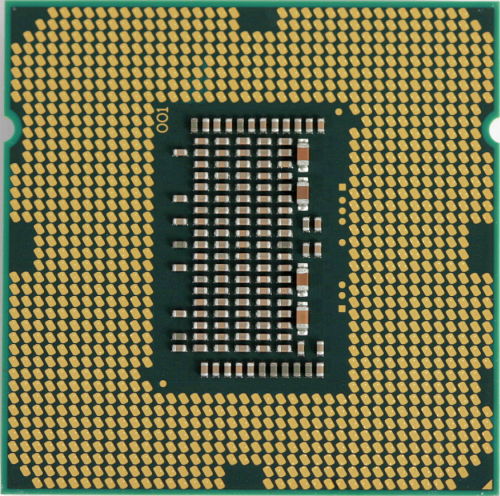
Testbed:
Motherboard:
MSI P55-GD80 (provided by MSI)
Intel P55
MSI 790GX-GD70 (provided by MSI)
AMD 790GX/SB750
MSI DKA790GX (provided by MSI)
AMD 790GX/SB750
Gigabyte GA-EP45-UD3P (provided by Gigabyte)
Intel P45/iCH10R
Intel DX58SO "Smackover" (provided by Intel)
Intel X58/iCH10R
CPU:
Intel Core i5 750 (provided by Intel)
Intel Core i5 870 (provided by Intel)
AMD Phenom II 905e (provided by AMD)
AMD Phenom II 720 Black Edition (provided by AMD)
AMD Phenom II 810 (provided by AMD)
AMD Phenom II 955 Black Edition (provided by AMD)
Intel Q9450 (provided by Intel)
Intel Q(X)9650 (provided by Intel)
Intel Core i7 920 (provided by Intel)
Intel Core i7 975XE (provided by Intel)
CPU-Cooler:
Scythe Kabuto (provided by Scythe-Europe) for AMD and Intel E/Q
Thermalright Ultra 120 eXtreme 1366 (provided by Thermalright) for Intel 1366
Thermalright MUX-120 1156 (provided by Thermalright) for Intel 1156
Memory:
Kingston 2GB Kit PC2-9600U KHX1200D2K2/2G (provided by Kingston)
1066MHz CL5-5-5-15 CR2T at 1.90V for AMD DDR2
Qimonda 3GB Kit PC3-8500U (provided by Qimonda)
1066MHz CL7-7-7-20 CR1T at 1.55V for Intel i7
Kingston 3GB Kit PC3-10600U KHX1600D3K3/2GX (provided by Kingston)
1333MHz CL7-7-7-20 CR1T at 1.50V for AMD DDR3 and Intel P55
1440MHz CL7-7-7-20 CR1T at 1.50V for Intel P55
1600MHz CL8-8-8-23 CR1T at 1.60V for AMD DDR3 FSB overclocking
1644MHz CL9-8-8-23 CR1T at 1.60V for Intel P55
1800MHz CL9-8-8-23 CR1T at 1.65V for Intel P55
Graphics Card:
MSI R4850-2D1G-OC (provided by MSI)
Power supply:
PC Power & Cooling Silencer 500W (provided by PC Power & Cooling)
Hard disk:
Samsung F1 1000GB (provided by Ditech)
Case fans:
SilenX iXtrema Pro 14dB(A) (provided by PC-Cooling.at)
Scythe DFS122512LS
Case:
Cooler Master Stacker 831 Lite (provided by Cooler Master)
OS:
Since we are still not fans of Vista, all tests are performed with XP SP3. As 64-bit software is still not very common, we stick with the 32-bit version.
As you know the i7-870 runs at 2.93GHz, has four cores, supports hyperthreading and has a TDP of 95W. Of course the i7-8xx series features a PCIe 2.0 x16 controller which can be split to two x8 ports. The Turbo has been improved, for core one you get 3.60GHz, the second is 3.46GHz and the other two go up to 3.20GHz. Surprisingly the VCore is lower compared to the i5 series and is 1.17500V. We don't have an i7-950 CPU, but we suspect it will give this CPU a run for its money. We don't think hyperthreading is really as beneficial as Intel would like to believe you. In most cases it does nothing, in some it does improve performance, but there are some applications in which it will reduce performance.
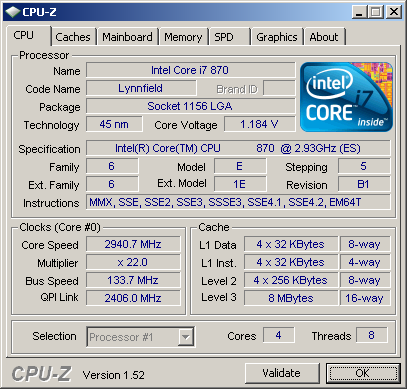
While Turbo mode is a nice feature for all users who don't want fiddle with overclocking settings, it will increase the performance especially with applications not optimized for multithreading. However, we guess everyone reading our site knows how to handle these things, so we don't really care about Turbo mode.
Overclocking:
As usual when overclocking you should disable the turbo, but ignore all the warnings about disabling EIST, Speedstep or any other energy saving settings. This is only necessary for extreme overclockers with liquid nitrogen. We only use an air-cooler, so let's see what it can do.
If you recall our i5-750 review, we could not explain why the voltages increased. Reason for this behavior is Load Line Calibration. The problem is, the settings are reversed in the BIOS, so disabled means enabled and vice versa.
For 3.60GHz and Load Line Calibration (LLC) disabled you need about 1.2750V VCore or you enable LLC and stay with the 1.1750V. With LLC disabled the VCore will drop about 0.100V. If you leave the BIOS to auto, most boards will increase the voltage, our board does to 1.3500V.
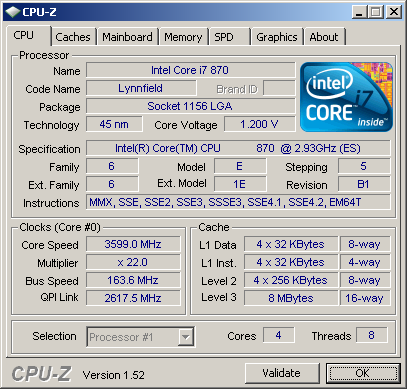
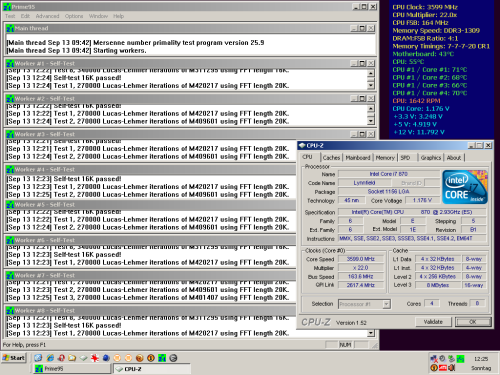
The next step was to go for 4GHz which is the magical barrier. We upped the VCore to 1.3750V and VTT to 1.222V. With Turbo disabled, all cores ran at this speed, and they ran like a charm.
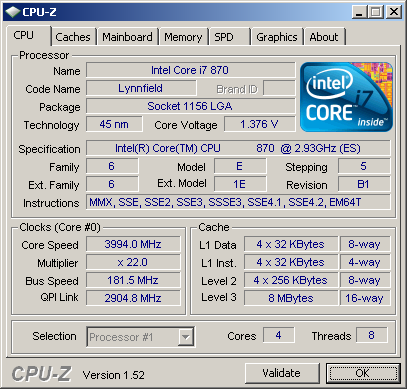
And now it gets difficult. If you keep hyperthreading enabled it is much harder to get higher clocks. Also the VDroop is very high on Intel i5/i7 CPUs, so you get higher clocks when you have a feature such as "Load Line Calibration" or "VDroop control" enabled. Of course this does increase power-consumption. While we could get 4.20GHz at 1.4000VCore LLC enabled and a VTT/QPI voltage of 1.270V we could run a stable test. This test failed with 4.3GHz but all our benches run fine, because they do not use 100% of the CPU. Besides that, Prime doubles the temperature in the core which can overshoot 90°C which is not healthy at all.
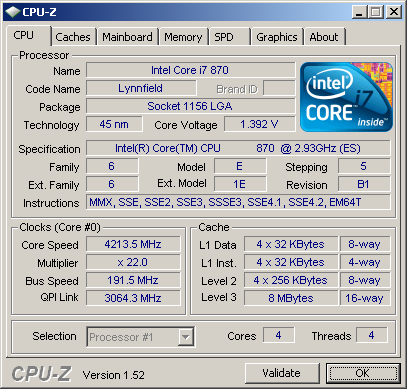
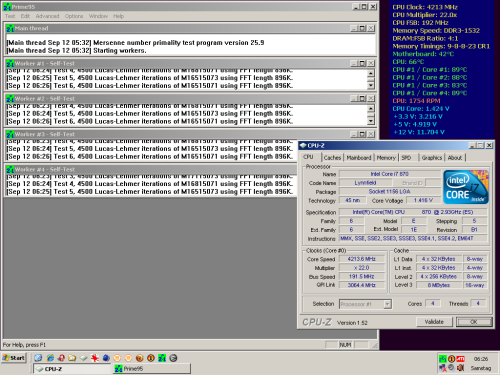
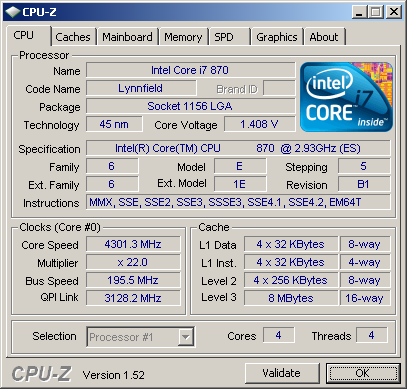
Under-Voltaging:
At least in Europe the market is shifting to a more "green" shade with ever growing environmental awareness. Getting most performance at the lowest possible energy cost does matter, because energy is expensive in western Europe. Lower voltaging will give you the same performance compared to the standard setting but shave off some bucks from your energy bill. With the Core i5/i7 series, you need to disable Turbo and hyperthreading, of course both of them will increase power consumption. We did not only lower the VCore to 1.075V and disabled Load Line Calibration. We also reduced the VTT to 0.965V. It worked quite well.
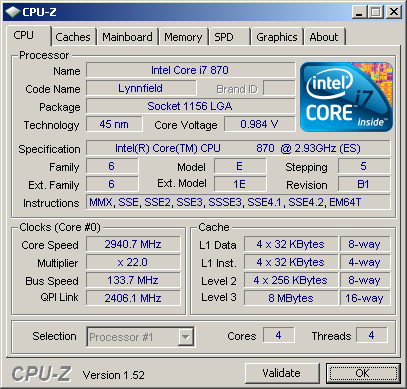
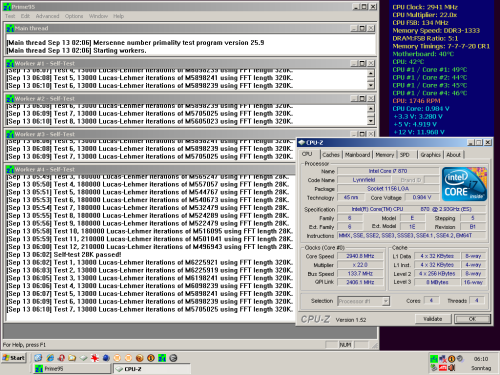
Our benchmarks are quite self-explanatory. Beside the usual benchmarks we included the Far Cry 2 Bench, which should show only the benefit of a faster CPU. As already explained for better comparison we only benched in non-HT mode and non-Turbo mode, to get comparable results on a clock to clock basis. Also note, we did some tests with C-States enabled (CS en) and C-States disabled (CS dis). C-State disabled gives higher performance but also increases power-consumption especially in idle-mode.
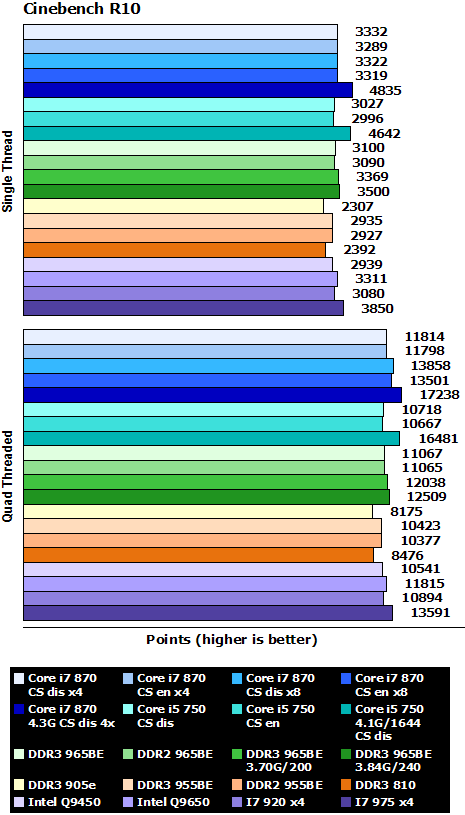
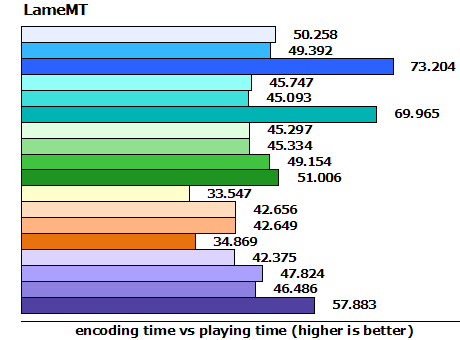
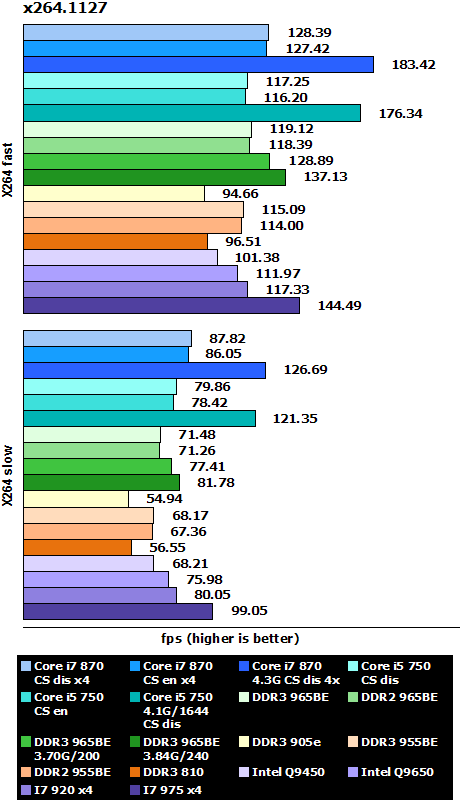
3DMark 2003 run at 1600x1200, 3DMark 2006 used defaults. As you can see, more CPU muscle doesn't really help. FarCry2 benching is a mess, the results vary quite a lot, the more often you do it the slower it gets. But anyway, the results are still quite close.
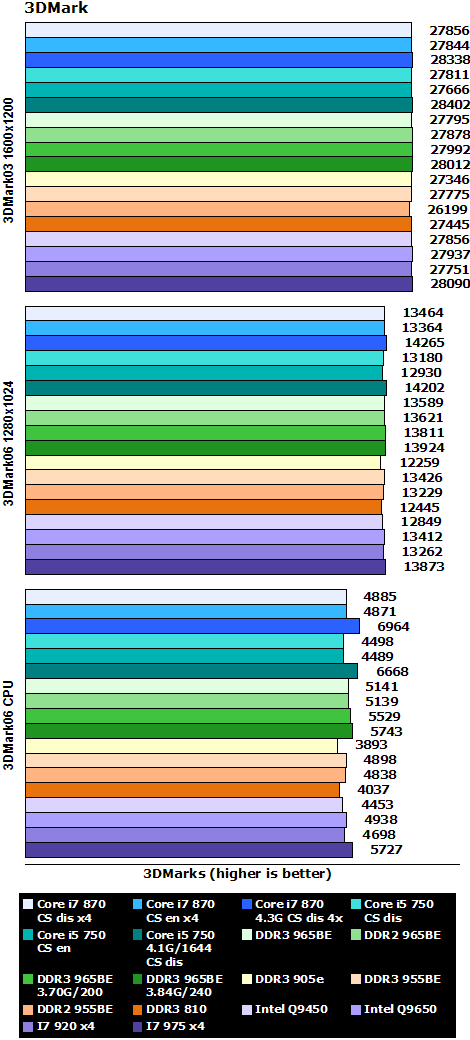

As usual our power-consumption test. This time you have to consider, all tests were done with C-States enabled (CS en) or C-States disabled (CS dis). The later prevents the CPU from going into "deep-sleep" which does increase the power-consumption especially in idle power. Due to the lower VCore but higher clock the i7-850 is more efficient and even beats its predecessor.
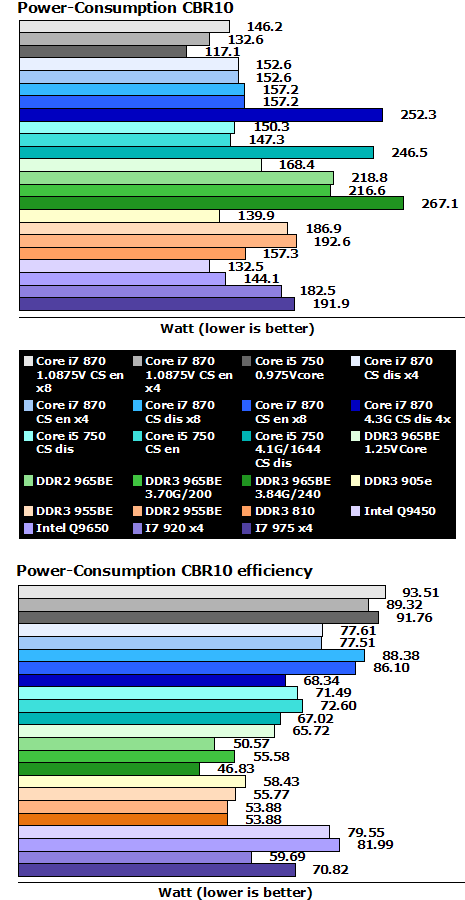
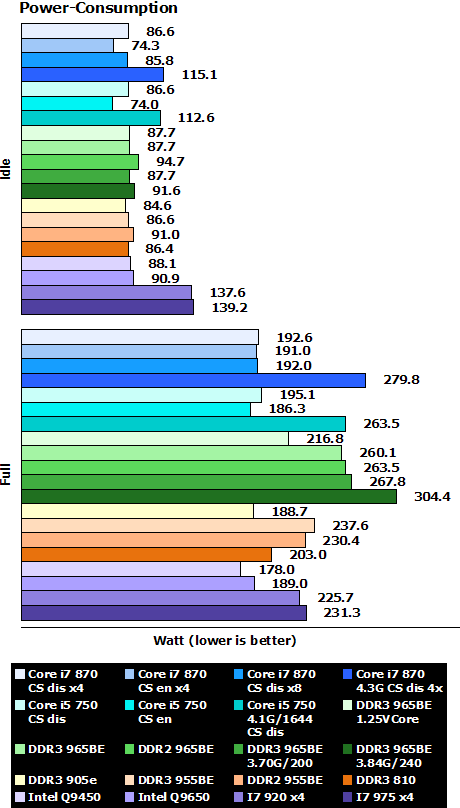
Before we can do a conclusion, again we give you the overall scores. Of course the i7-870 is faster compared to the i7 920 due to the higher clock. If you consider the higher turbo, when enabled, then the i7 870 will match the i7-950. The dual-channel memory interface does not limit its performance.
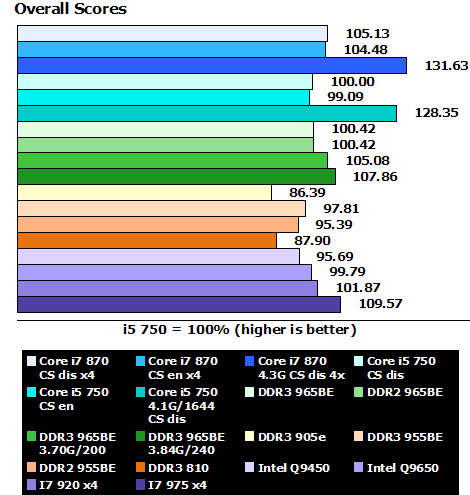
We have told you that hyperthreading can hurt performance. To illustrate this behavior we have benched x264 with hyperthreading enabled and also run the bench with eight threads (8T). Hyperthreading and eight threads pays off only in one bench.
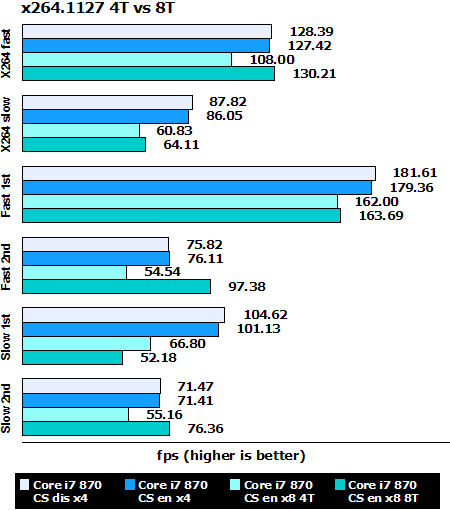
To give you a better overview we compare system costs. We calculated the cost of the used mainboards, CPUs and graphics-card and also the lowest possible price for a 4GB kit for dual-channel or a 3GB kit for triple-channel. Memory of course PC3-12800 (1600MHz) with CL8-8-8-24 and PC2-8500 CL5-5-5-18. Last week we saw an increase of prices in the DDR2 market, which does hurt AMD a bit. So the overclocking memory settings may not apply but it gives you a good overview. The Q9450 is not longer readily available, and if you find it, you'll find it at horribly high prices, so we used Q9550 pricing. As we have written in our AMD Phenom II 965 Black Edition review this CPU is too expensive, but so is the i7-750. You get the best price/performance ratio with an AMD Phenom II 955 Black Edition running on a DDR2 board but the i5-750 is also very close in overclocked settings.
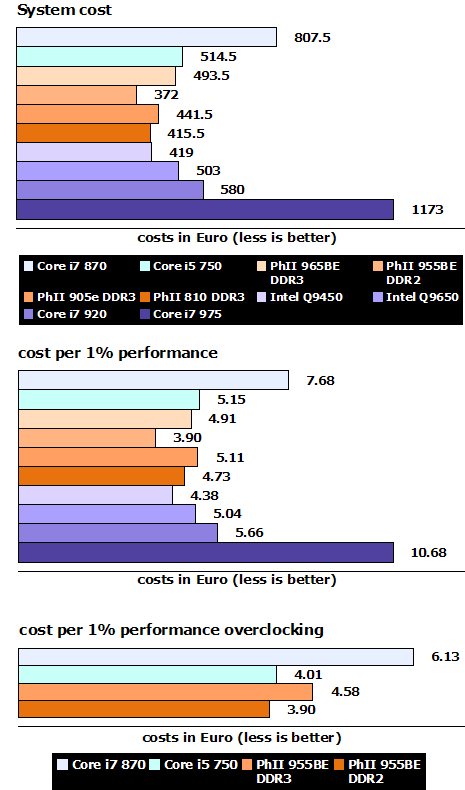
Conclusion:
For some reason Intel thinks we need an i7-870. The i7-950 is priced equally so you can choose if you take either an dual-channel or triple-channel board. The naming scheme will confuse customers while performance is on par.
The i7-870 is priced €459,- that's a tad more expensive as the i7-950 which costs you €454,-.
Users who know their applications will not be hurt by hyperthreading, can choose this CPU, but for the normal customer we don't see any reason. The i7-870 costs nearly three times as much as an i7-750, but it only delivers a mere 4% performance increase (without turbo).
On the other hand Intel is cannibalizing the 1366 market. Apart from more PCIe x16 lanes with a X58 board, there is really no reason whatsoever to buy a 1366 platform.
